Construction Materials And Technology: UNIT IV: Construction Equipments
Material Handling Equipments in Construction
Materials handling is loading, moving and unloading of materials. To perform the action safely and economically, different types of tackles, gadgets and equipments are used, which are called as material handling equipments.
MATERIAL HANDLING EQUIPMENTS
Materials handling is loading, moving and
unloading of materials. To perform the action safely and economically,
different types of tackles, gadgets and equipments are used, which are called
as material handling equipments. The essential requirements of a good materials
handling system may be summarized as:
❖ Efficient and safe
movement of materials to the desired place.
❖Timely movement of the
materials when needed.
❖ Supply of materials at
the desired rate.
❖ Storing of materials
utilizing minimum space.
❖ Lowest cost solution to
the materials handling activities.
Material Handling equipment's are used in
movement of bulk, packaged, & individual products as per the work
requirement. Broadly material handling equipment's can be classified into the
following categories:
(i) Hoists: Hoist is a device for
raising or lowering a load by means of a drum or wheel lift to which wraps the
rope or chain. It can be operated by hand, is driven electrically or
pneumatically, and the chain or wire rope fibers are used as lifting device.
The load connected to the lifting means of a lifting hook. Following are the
widely used hoisting equipments:
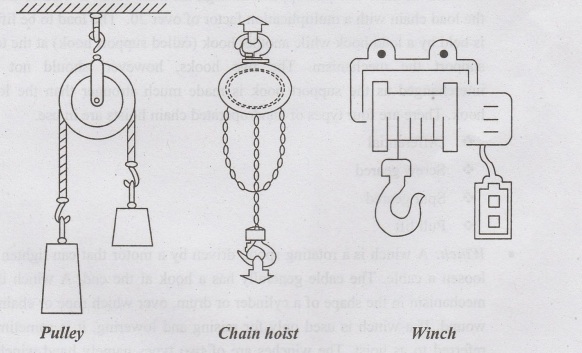
* Pulley
is
a wheel on an axle or shaft that is designed to support movement and change of
direction of a cable or belt along its circumference. Pulleys are used in a
variety of ways to lift loads, apply forces, and to transmit power. The
assembly of the wheel, axle, and supporting shell is referred to as a
"block." A pulley may also be called a sheave or drum and may have a
groove between two flanges around its circumference. The drive element of a
pulley system can be a rope, cable, belt, or chain that runs over the pulley
inside the groove. The pulley and sheave blocks suitable for lifting rough
surfaces and heavy loads. For this purpose, the chains and wire ropes are used.
The alloy chains are best suited for hoisting operation. The weakest component
of this system is the load hook. The hook fails by straightening. Once the hook
gets elongated or straightened, it should be replaced.
* Chain hoist: The chain hoists are the popular mechanism
for lifting loads of upto tonnes. The system consists of two sets of chains,
namely the hand and load chain. The hand chains are particularly useful for the
isolated location, where an electric motor or other types of mechanical
equipments are not available. The pull applied through the hand chain is
transmitted to the load chain with a multiplication factor of over 20. The load
to be lifted is held by a load hook while another hook (called support hook) at
the top, support the mechanism. The two hooks, however, should not be
interchanged as the support hook is made much stronger than the load hook.
There are four types of hand-operated chain hoists are in use.
❖ Differential
❖ Screw geared
❖ Spur geared
❖ Pull lift
* Winch: A
winch is a rotating spool, driven by a motor that can tighten or loosen a
cable. The cable generally has a hook at the end. A winch is a mechanism in the
shape of a cylinder or drum, over which rope or chain is wound. If a winch is
used only for raising and lowering, it is sometimes referred to as hoist. The
winches are of two types namely hand winches and power winches.
(ii) Conveyors:
Conveyors are useful for moving material between two fixed workstations, either
continuously or intermittently. They are mainly used for continuous or mass
material handling operations, and most suitable for operations where the flow
is more or less steady. Conveyors may be of various types, with rollers, wheels
or belts to help move the material along, and may be power-driven or may roll
freely. The decision to provide conveyors must be taken with care, since they
are usually costly to install. However, they are less flexible and, where two
or more converge, it is necessary to coordinate the speeds at which the two
conveyors move. Various types of conveyors used for material handling are
discussed below:
* Belt
conveyors: A belt conveyor consists of an endless flat and flexible
belt of sufficient strength, made of fabric, rubber, plastic, leather or metal,
which is laid over two metallic flat pulleys at two ends, and driven in one
direction by driving one of the two end pulleys. Material is placed on this
moving belt for transportation. The active half of the belt is supported by
idler rollers or slider bed. The return half of the belt may or may not be
supported, as it generally does not carry any additional load other than its
own weight. The endless belt is kept tight by a belt tensioning arrangement.
Types of belt conveyor are:
❖ Flat
Belt Conveyor
❖ Troughed Belt Conveyor
❖ Closed Belt Conveyor
❖ Metallic Belt Conveyor
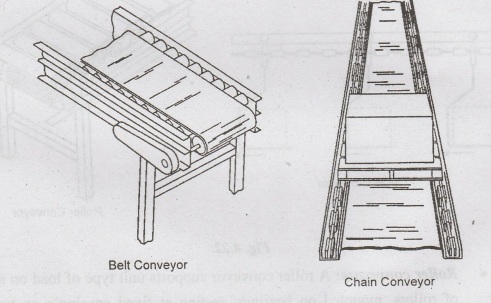
* Chain
conveyors: The term chain conveyor means a group of
different types of conveyors used in diverse applications, characterized by one
or multiple strands of endless chains that travel entire conveyor path, driven
by one or a set of sprockets at one end and supported by one or a set of
sprockets on the other end. Materials to be conveyed are carried directly on
the links of the chain or on specially designed elements attached to the chain.
The load carrying chain is generally supported on idle sprockets or guide ways.
The endless chains are kept tight by suitable chain tensioning device at the
non-driven end. Different types of chain conveyors are Apron or Pan Conveyor
and Cross-Bar or Arm Conveyor. no
* Cable
conveyors: These conveyors form a distinct group of materials
handling equipment to transport people and bulk materials in load carrying
buckets, using overhead moving cables and/or wire ropes and are com- posed of
one or more spans from the loading point to the discharge point/points covering
long distances upto several kilometers. These conveyors are also known as
ropeways or aerial tramways.
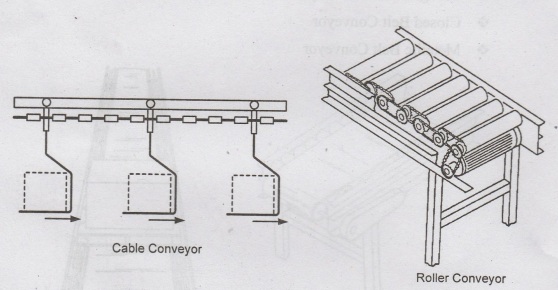
* Roller
conveyors: A roller conveyor supports unit type of load on a
series of rollers, mounted on bearings, resting at fixed spacing's on two side
frames which are fixed to stands or trestles placed on floor at certain
intervals. A roller conveyor essentially coveys unit loads with at least one
rigid, near flat surface to touch and maintain stable equilibrium on the
rollers, like ingots, plates, rolled stock, pipes, logs, boxes, crates,
moulding vboxes etc. The spacing of rollers depend on the size of the unit
loads to be carried, such that the load is carried at least by two rollers at
any point of time. Roller conveyors are classified into two types according to
the principle of conveying action as Unpowered or Idle Roller Conveyor and
Powered or Live Roller Conveyor.
* Screw
conveyors: A screw conveyor consists of a continuous or
interrupted helical screw fastened to a shaft which is rotated in a U-shaped
trough to push fine grained bulk material through the trough. The bulk material
slides along the trough by the same principle a nut prevented from rotating
would move in a rotating screw. The load is prevented from rotating with screw
by the weight of the material and by the friction of the material against the
wall of the trough. A screw conveyor is suitable for any pulverized or granular
non viscous material, and even at high temperature. The conveyor is
particularly suitable for mixing or blending more than one material during
transportation, and also for controlling feed rate of materials in a processing
plant. It is also not suitable for large- lumped, packing or sticking
materials.
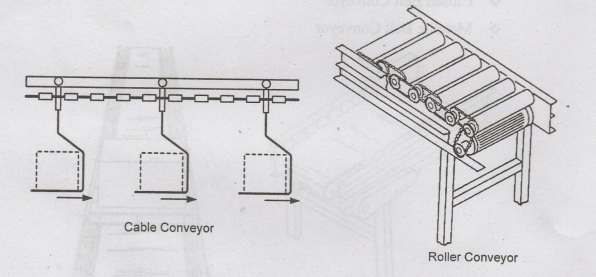
* Chute
conveyors: Chute Conveyor is one of the least expensive methods of
conveying material. It is the simplest example of gravity-operated conveyor.
Chutes are inclined connections between two systems of materials handling
equipment or production equipment, in the form of troughs of definite
geometrical cross section or pipes, which convey unit or bulk load by gravity.
A chute may connect two conveying mechanisms, two process equipment or may be
installed between one materials handling equipment and one processing
equipment. Depending on the load to be handled, chutes are made of various
size, shape and material.
(iii) Cranes: A
crane is a piece of heavy machinery that is a tower or platform that is
equipped with cables and pulleys. Cranes have a long history of being a staple
in construction that reaches back thousands of years. It was during the
industrial revolution that cranes became integral to the modernization of the
world, replacing the manual pulley system with an engine and an operator that
preceded them. There are various types of cranes used in civil engineering
construction works. They are used to lift and lower materials. The most common
types of cranes used in the construction industry are discussed below:
* Derrick Crane: A derrick is a special
type of crane in which the distance from the end of the jib to the pillar can
be changed. The derrick cranes are of two types, namely Guy derrick and Stiff
leg derrick. A guy derrick consists essentially of a pivoted pillar that is
braced by guy ropes, and a jib that is attached at the base of the pillar. The
inclination of the jib is controlled by a tackle that connects the top ends of
the pillar and jib. The hoisting rope extends from the end of the jib, over the
top of the pillar, to the base of the pillar, where it is fastened to a drum. A
stiff leg derrick is similar to a guy derrick except that its jib is movable
and may be secured at different heights on the tower, or pillar. Stiff leg
derricks are used mostly in building construction. Guy derrick can be
constructed up to 200 tonnes capacity. In stiff leg type derricks, the guy
wires are replaced by trussed structure. This type of derricks is suitable for
loads from 10 to 50 tonnes.
* Mobile
Cranes: This is the most basic type of crane and consists of a
steel truss or telescopic boom mounted on some kind of mobile platform. This
platform could be wheeled, a rail or even a cat truck. The boom is hinged at
the bottom and can be raised or lowered by cables or hydraulic cylinders. Some
mobile cranes are even able to be driven on the highway. Their ability to
navigate around job sites and carry large amounts of weight makes mobile cranes
a very popular addition to many projects. In most cases, they don't require
much effort to assemble or setup.
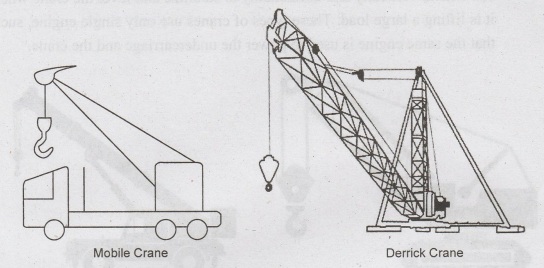
* Crawler
Crane: Crawler cranes are track vehicles. Instead of wheels,
crawlers are built on an undercarriage fitted with a pair of rubber tracks.
Though this limits the crawler's turning capacity, the tracks make it possible
to use on soft ground and sites with limited improvement without sinking. Their
main advantage is that it can move mostly on any surface of the earth due to
its crawlers as it transfers its load to a great area. Hence it can be used at
unprepared sites without worrying about anything. Some crawler cranes have an
attached telescopic arm that allows it to change its size, making them highly
adaptable on many terrains. It is very heavy and move on tracks hence mobility
is not easy and take more time and will cost more money. But it can be moved by
trucks easily and without costing much money.
* Rough
Terrain Crane: A rough terrain crane is built similarly to
a crawler crane, but instead of tracks, the undercarriage is outfitted with
four large rubber tires that are typically equipped with four-wheel drive. A
normal vehicle mounted crane cannot be used in off road applications, hence
rough terrain cranes are used. Outriggers are used for stabilizing the crane
while working. They contain only one engine which means that same engine is
used for undercarriage and crane. Rough terrain cranes are also fitted with
telescopic booms and outriggers to improve stability and make mobility much
more manageable in tight and rough areas. The outriggers can extend vertically
and horizontally to stabilize and level the crane when it is lifting a large
load. These types of cranes use only single engine, such that the same engine
is used to power the undercarriage and the crane.
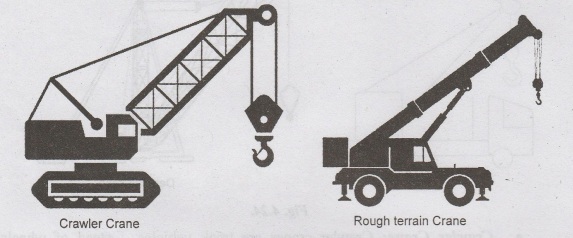
* Truck Mounted Crane: These types of cranes are mounted on a
rubber tire truck and provide excellent mobility. The outriggers will extend
vertically or horizontally and are used to stabilize and level the crane when
it is hoisting a load of materials. Truck-mounted cranes are made up of two
parts: the carrier (truck), and the boom (arm). Due to their unique build,
they're able to travel easily on the road with no unique set up or
transportation equipment. Its main advantage is that it can travel on highways itself,
which makes it easy and less expensive. It does not need any other vehicles to
transport it. They can be rotated up to 180 degrees. But some of them rotate up
to 360 degrees but these are more expensive.
* Telescopic Handler Cranes: Telescopic cranes are equipped with a boom
(arm) outfitted with a hydraulic cylinder that allows it to change length, like
a telescope. The boom has a number of tubes that are fitted inside each other.
Then hydraulic mechanisms extend or retract the tubes to length or shorten the
boom. Although it's considered a fixed crane, many telescopic cranes are
mounted on a truck to transport to and from different worksites. Their
main purpose is to handle loads and install frame trusses in buildings. They
are designed too simple to improve workability. They can rotate up to 360
degrees and also have outriggers to maintain its stability. They look like
forklift trucks. Due to the unique nature of their boom being able to collapse
and compact itself, telescopic cranes are highly adaptable for a variety of
situations, such as short-term construction jobs as well as some rescue
operations during natural disasters or other emergencies.
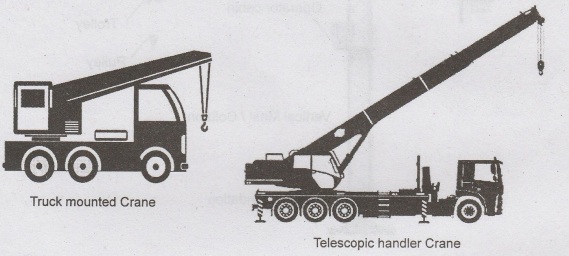
* Tower
Cranes: A tower crane is considered to be a modern form of a
balance crane and is the mostly used cranes in today's world. Usually, they are
fixed to the ground in concrete base or attached to the side of structures.
They can lift load up to 30 tons approximately. Due to their size, tower cranes
are equipped with an operating cab that controls the entire crane. The
operators of the crane mostly use radio signals as a medium for communication
to hook or unhook the load. Tower cranes have their jib extending horizontally
from the mast (tower part), which itself rests on a concrete base. A travelling
jib is able to move up and down, while the fixed jib has an operating dolly
that moves materials horizontally. The engine (called a slewing unit) that
controls the rotation of the crane sits on the top of the mast. Counterweights
are also provided to make the crane more stable while swinging the boom. Due to
their size, tower cranes are built along with the building, growing alongside
it; once the building is complete, the process is reversed. Commonly used in
the construction of tall buildings, tower cranes are awesome machines that
offer amazing lifting capabilities.
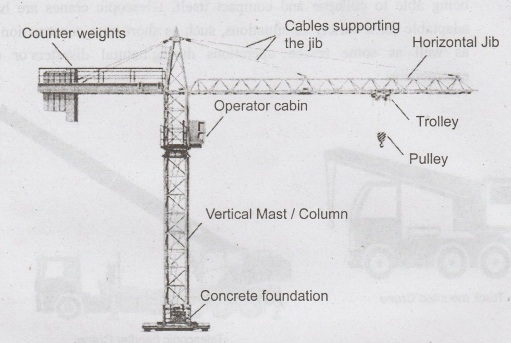
* Overhead
/ Gantry Crane: The Gantry cranes or overhead cranes are the
indispensable machines in factories, workshops. These types of cranes are also
known as suspended cranes. In large workshops, there are separate machines for
fabrications or repairs of the machine parts. The machine or the components,
which are to be repaired, can be transferred to the place of fabrication or
assembly with the help of Gantry cranes. Larger overhead cranes (also known as
goliath cranes) can be found in use in shipyards and large outdoor
manufacturing plants. The hoist is set on a trolley which will move in one
direction along one or two beams, which move at angles to that direction along
elevated or ground level tracks, often mounted along the side of an assembly
area. The most significant difference between a bridge and gantry crane is that
the gantry crane is supported by two a- frame steel legs and is typically built
on a track.
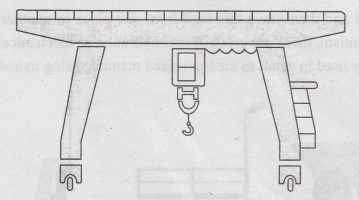
(iv)
Trucks: Industrial vehicles/trucks is one of the most common
group of materials handling equipment used in industry as well as in day to day
distribution of goods in warehouses, large stores, etc. The entire range of
industrial vehicles/trucks is generally sub-classified into two group's namely
non-powered truck, (also called hand trucks) and powered trucks. The operation
and constructional features of some of the common types of industrial trucks
are discussed below:
* Hand
trucks: Hand trucks, as the name implies, have no source of
motive power, these are generally moved manually or are attached to other
powered moving equipment/units. Hand trucks are classified into three sub
groups (i) 2-Wheel hand truck, (ii) multiple-wheel hand truck and (iii) Hand
lift truck.
Two-wheel
Hand Trucks are generally used for moving unit or
unitized loads like bricks, cement bags, barrels, packages etc. by pushing the
truck manually. Basically it consists of two long handles fixed by a number of
cross bars which from the frame to carry the load. Two wheels mounted on an
axle are fixed on far end of the frame. Two short legs are generally fixed to
the two handles at the other end to allow the hand truck to stay in a
horizontal position during loading and unloading of the truck.
Multiple-wheel
Hand Trucks generally consists of a platform or
framework mounted on 3 or 4 or more number of wheels. The truck is generally
provided with a handle for pushing or pulling the platform. Certain trucks are
provided with no handle or detachable handle.
Hand
Lift Trucks are provided with a mechanism of lifting its
platform, which can be rolled under a pallet or skid, and raised to lift the
pallet or skid with load to clear the ground and then move this load from one place
to another. Depending on the lifting mechanism, these are grouped into
hydraulic or mechanical type. Hand lift trucks are widely used in small to
medium sized manufacturing industries.

* Powered
trucks: When a vehicle / truck contain its own source of motive
power, it is called a powered truck. Power trucks are divided into several
categories of equipment. The wide varieties of powered industrial trucks have
been classified into the following six groups as
* mode of action
* power source
* type of wheel
* mode of control
* height of lift
* mode of travel
The
powered trucks can be further subdivided into Forklift Truck, Tractor and Dump
Trucks.
Fork
lift trucks are the most versatile, useful and widely
used equipment as industrial lift trucks. These are self loading,
counterbalanced, powered, wheeled vehicles, with the operator seating on the
vehicle, designed to raise, move and lower load on forks or other attachments
fastened to a mast which is fixed in front of the vehicle to allow lifting and
stacking of loads. Forklift trucks are used for lifting, lowering, stacking,
unstacking, loading and unloading and maneuvering of medium to large weight,
uniform shaped unit loads, intermittently. The capacity of this equipment
varies from 1 tonne to 60 tonnes. However, the limitations of this equipment
are it usually requires pallet/skid/ container for lifting and requires skilled
operator. It is suitable for short hauls with a travel speed of 10-15 kmph.
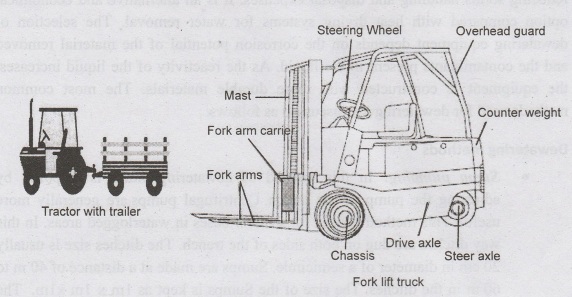
Tractor is
a vehicle, having its own source of motive power, used as a prime material
handling equipment. It gives motion to another or a group of other vehicles
which do not have their own motive power, such as trailers, semitrailers, etc.
Tractors have many uses as construction equipment like earthmoving, aggregates,
cement bags, bricks and even water container carrying works. While their
primary purpose may be to pull or push loads, they are also used as mounts for
many types of accessories, such as front-end shovels, bulldozers and others.
There are types and sizes to fit almost any job for which they are usable.
Tractors may be divided into two major types as crawler tractors and wheel
tractors.
Dump truck, also known also as a tipper truck, is used for hauling
sand, gravel, excavated earth, bituminous aggregate in construction industry. A
typical dump truck is equipped with an open-box bed, which is hinged at the
rear and equipped with hydraulic rams to lift the front, allowing the material
in the bed to be deposited on the ground behind the truck at the site of
delivery.
Construction Materials And Technology: UNIT IV: Construction Equipments : Tag: : - Material Handling Equipments in Construction
Related Topics
Related Subjects
Construction Materials and Technology
CE3302 3rd Semester Civil Dept 2021 Regulation | 3rd Semester Civil Dept 2021 Regulation
